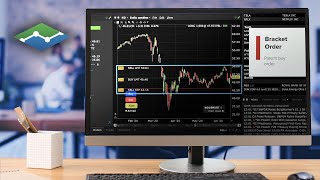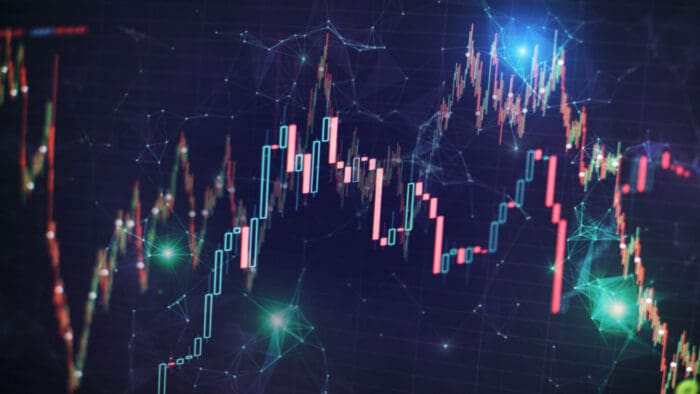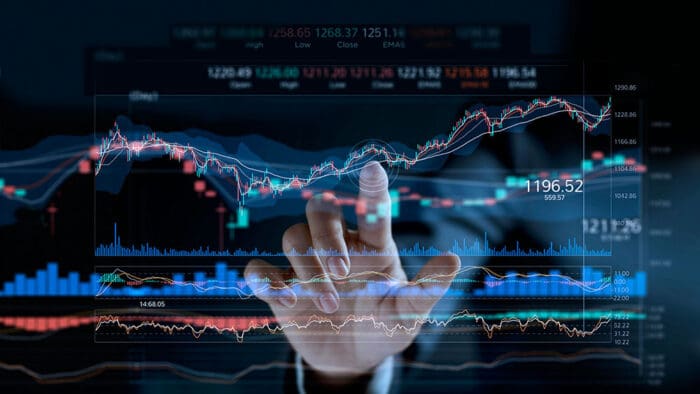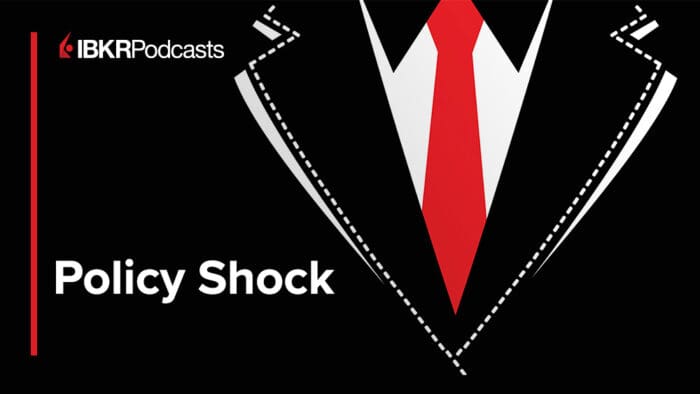Michael Normyle – Nasdaq’s US Economist joins IBKR’s Jeff Praissman for their monthly podcast to discuss the Goldilocks economy and the effect that possible tariffs and immigration policies may have in 2025.
Summary – IBKR Podcasts Ep. 229
The following is a summary of a live audio recording and may contain errors in spelling or grammar. Although IBKR has edited for clarity no material changes have been made.
Jeff Praissman
Hi, everyone. Welcome to the IBKR podcast studio. I’m your host, Jeff Praissman. It’s my pleasure to welcome back to our studio for a monthly podcast, Nasdaq’s Michael Normyle. Hi, Mike, how are you?
Michael Normyle
Doing well, thanks. Thanks for having me back.
Jeff Praissman
Oh, it’s always a pleasure. So today, I want to dive into something that’s been a hot topic—there’s been a lot of talk that the U.S. and other developed economies are in a quote-unquote “Goldilocks zone.” Can you explain to our listeners what exactly that means?
Michael Normyle
Sure. That’s how we’ve been describing the situation we’re seeing in a number of advanced economies, where inflation has cooled off and is pretty close to central bank targets. The labor market has also cooled off from extreme levels of tightness, but we’ve only seen unemployment rates increase relatively modestly from historic lows.
And then, lastly, these economies have generally avoided recession in the past year, with many seeing solid—but not too strong—economic growth. So overall, their economies are not too hot, not too cold, which is why we call it the Goldilocks zone. That’s helped their central banks pivot to cutting rates last year and into this year.
This is especially true for the U.S., where headline PCE inflation is just above the Fed’s 2 percent target, the unemployment rate is 4 percent, and the economy saw about 3 percent real GDP growth last year.
Jeff Praissman
What have been some of the biggest contributors supporting the U.S. economy?
Michael Normyle
I’d say there are two big factors for the U.S., and they’re the reasons why we avoided recession in 2023, when a lot of people thought there could be one. And then again last year. Those factors are government spending and consumer spending.
On the government spending side, we had big-ticket programs like the CHIPS Act and the Inflation Reduction Act, which subsidized spending on chip factories, EV battery plants, and similar initiatives—costing billions and billions of dollars.
For consumer spending, multiple factors played a role. Fixed-rate mortgages partly insulated consumers from the Fed’s higher rates. A healthy labor market, combined with falling inflation, drove real wage gains—meaning that after inflation, there was still wage growth left over. Additionally, housing and equity asset appreciation increased household wealth, creating a “wealth effect” where people feel wealthier and, in turn, spend more.
Overall, when we have strong consumer spending in the U.S., it usually means the economy is doing well, since consumer spending alone accounts for about 70 percent of U.S. GDP.
Jeff Praissman
Obviously, with the new president—especially from a different party—there will be changes, and tariffs have really been in the news lately. Before we get into the impact they may have on inflation, I’d like to drill down on different countries’ shares of U.S. imports. The Eurozone, Mexico, China, Canada, Taiwan, South Korea, and Vietnam—how are they all doing?
Michael Normyle
Yeah, this is something that has actually changed a lot in recent years, dating back to President Trump’s first term, when he imposed tariffs on China starting in 2018. Compared to the discussions we’ve seen at the start of President Trump’s second term, those earlier tariffs were more narrowly focused, but they still had a lasting effect on U.S. trade patterns.
Looking at the shares of U.S. goods imports, China’s share has essentially been cut in half since 2018, falling to about 13 percent. The added cost of importing from China pushed companies to change their suppliers and supply chains.
As companies adjusted their operations—whether by building new factories or staffing new office locations—we saw some beneficiaries of the shift away from China. Specifically, China’s neighbors, like Taiwan, South Korea, and Vietnam, saw their combined share of U.S. goods imports nearly double to 12 percent.
We’ve also seen cases of “friendshoring,” with the share of the Eurozone—a U.S. ally—rising slightly to 17 percent, as well as “nearshoring,” with Mexico’s share increasing to 16 percent. Now, the import shares of the Eurozone and Mexico are actually greater than China’s.
Jeff Praissman
We really can’t talk about imports without discussing trade deficits and surpluses. What are some of the bigger deficits and surpluses the U.S. has with other countries?
Michael Normyle
Exactly. This is one of the things President Trump is looking to address with tariffs—he wants to shrink our trade deficits with some countries.
Even after the 2018 tariffs, our biggest trade deficit is still with China, coming in at nearly $350 billion per year. Other major trade deficits include Mexico, at about $100 billion; Japan and Germany, both near $70 billion; Vietnam, over $50 billion; and Canada, about $30 billion. These countries could potentially be at greater risk of tariffs aimed at shrinking these deficits.
Jeff Praissman
In 2025, with the U.S. having intricate trade relationships with countries all over the world, what impact would increased tariffs have on inflation?
Michael Normyle
I think the impact is actually smaller than a lot of people might think, for a few reasons.
First, as a share of the economy, the U.S. is less reliant on trade than some other major economies. Trade accounts for about 11 percent of U.S. GDP, while goods exports make up around 7 percent—so it’s actually a relatively small piece of the economy overall.
Second, looking back at President Trump’s first term, tariffs had little impact on inflation, and the Fed was largely willing to look past them.
Third, as we’ve seen since 2018, companies can adjust supply chains to mitigate the impact of tariffs. So, while tariffs may create some upward pressure on inflation, it’s more like moving from 2.5 percent inflation to 3 percent—not a return to the 9 percent inflation we saw in 2022.
Jeff Praissman
Now, let’s stick with the global theme, but I don’t want to get political. The U.S. is a country of immigrants, and at various points in history, the numbers have ebbed and flowed. What effect would immigration restrictions have on the economy?
Michael Normyle
Strictly from a macroeconomic perspective, immigration is a labor supply issue. We actually saw how restricting labor supply impacted the economy during COVID—though that was a far more extreme example than any immigration restrictions would be.
During COVID, many people retired early to avoid getting sick. Enhanced unemployment benefits allowed people to hold out for the perfect job. Travel restrictions led to a drop in visa issuance. When the economy reopened as vaccines rolled out, there was a sudden demand for workers, but not enough workers to meet it. At the peak of the recovery, there were two job openings per unemployed person, compared to 1.2 in 2019.
With demand high and the labor pool smaller, people who switched jobs earned much higher wages—this was known as the Great Resignation period. As a result, wage growth for job switchers hit 8.5 percent year-over-year in 2022. Business wage costs have increased 25 percent from 2020 to today, which has been a key factor in the sticky inflation we’re still seeing.
Jeff Praissman
Are there certain sectors that would be more affected than others by immigration restrictions?
Michael Normyle
Yes. We’d likely see wage pressures, but they would be concentrated in sectors most reliant on unauthorized immigrants—such as construction, agriculture, and hospitality. Some of those higher wage costs could be passed on to consumers, but again, this would be far more modest than what we saw during COVID.
Jeff Praissman
Michael, this was a great conversation as always. Any final thoughts for our listeners?
Michael Normyle
Overall, the U.S. economy is in a good place. The economic impact of tariffs and immigration restrictions will likely be milder than many expect, and there are ways to mitigate potentially higher costs. There’s a good chance that 2025, from an economic perspective, will look a lot like 2024—just with slightly slower economic growth.
Jeff Praissman
Thanks again to Nasdaq’s Michael Normyle for stopping by the Interactive Brokers podcast studio.
For our listeners, you can find our podcast on our website under Education > Podcasts or on platforms like Amazon Music, Apple, Spotify, and more. For now, I’m Jeff Praissman.
Thank you for listening.
Join The Conversation
For specific platform feedback and suggestions, please submit it directly to our team using these instructions.
If you have an account-specific question or concern, please reach out to Client Services.
We encourage you to look through our FAQs before posting. Your question may already be covered!
Leave a Reply
Disclosure: Interactive Brokers
The analysis in this material is provided for information only and is not and should not be construed as an offer to sell or the solicitation of an offer to buy any security. To the extent that this material discusses general market activity, industry or sector trends or other broad-based economic or political conditions, it should not be construed as research or investment advice. To the extent that it includes references to specific securities, commodities, currencies, or other instruments, those references do not constitute a recommendation by IBKR to buy, sell or hold such investments. This material does not and is not intended to take into account the particular financial conditions, investment objectives or requirements of individual customers. Before acting on this material, you should consider whether it is suitable for your particular circumstances and, as necessary, seek professional advice.
The views and opinions expressed herein are those of the author and do not necessarily reflect the views of Interactive Brokers, its affiliates, or its employees.
Disclosure: Nasdaq
Index
Nasdaq® is a registered trademark of Nasdaq, Inc. The information contained above is provided for informational and educational purposes only, and nothing contained herein should be construed as investment advice, either on behalf of a particular security or an overall investment strategy. Neither Nasdaq, Inc. nor any of its affiliates makes any recommendation to buy or sell any security or any representation about the financial condition of any company. Statements regarding Nasdaq-listed companies or Nasdaq proprietary indexes are not guarantees of future performance. Actual results may differ materially from those expressed or implied. Past performance is not indicative of future results. Investors should undertake their own due diligence and carefully evaluate companies before investing. ADVICE FROM A SECURITIES PROFESSIONAL IS STRONGLY ADVISED.
© 2023. Nasdaq, Inc. All Rights Reserved.
Options
For the sake of simplicity, the examples included do not take into consideration commissions and other transaction fees, tax considerations, or margin requirements, which are factors that may significantly affect the economic consequences of a given strategy. An investor should review transaction costs, margin requirements and tax considerations with a broker and tax advisor before entering into any options strategy.
Options involve risk and are not suitable for everyone. Prior to buying or selling an option, a person must receive a copy of Characteristics and Risks of Standardized Options. Copies may be obtained from your broker, one of the exchanges or The Options Clearing Corporation, One North Wacker Drive, Suite 500, Chicago, IL 60606 or call 1-888-OPTIONS or visit www.888options.com.
Any strategies discussed, including examples using actual securities and price data, are strictly for illustrative and education purposes and are not to be construed as an endorsement, recommendation or solicitation to buy or sell securities.
© 2023. Nasdaq, Inc. All Rights Reserved.

















Disappointing as to why the reference to the fable Goldilocks was not explained. Shows ChatGpt is way better than humans in asking and getting answers.